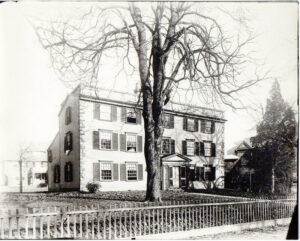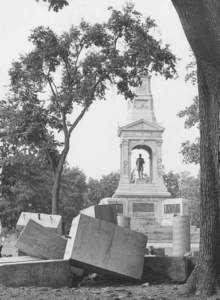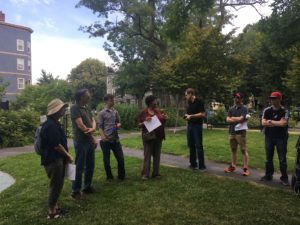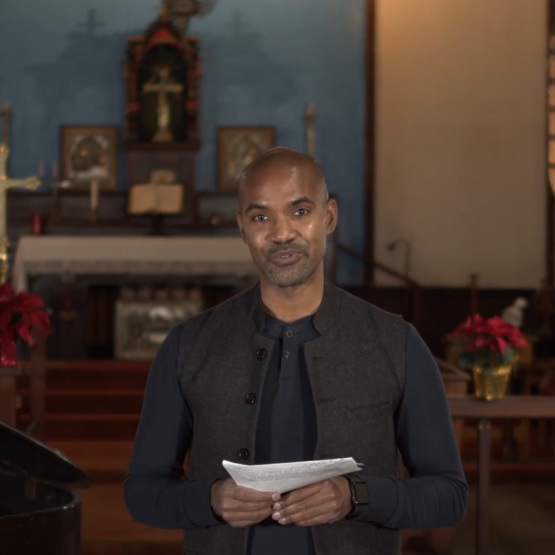
Black History in Action for Cambridgeport’s revival of St. Augustine’s Church honors a lengthy legacy
Above Image: Black History in Action for Cambridgeport’s Kris Manjapra inside St. Augustine’s Church. (Photo: Cambridge Community Foundation)
By Beth Folsom, 2023
In December 1886, the Cambridge Chronicle noted that St. Peter’s Episcopal congregation in Central Square had just commissioned a new mission church. Located on Allston Street in Cambridgeport, “a great distance” from St. Peter’s, this new building would serve the people of the Cambridgeport neighborhood, and would be known as St. Phillip’s. Over the next several decades, the new congregation grew and flourished. But by the late 1910s and early 1920s, changing demographics and a proliferation of churches meant that St. Phillip’s faced increasing competition for both parishioners and financial resources. By 1926, a dwindling parish population led St. Phillip’s to sell the building to the African Orthodox Church. They renamed it St. Augustine’s.
By the time of St. Augustine’s founding, the Rev. George McGuire had been living in the Cambridge area for over two decades. McGuire had come to the Boston College of Physicians and Surgeons from Antigua to study medicine. He was also an ordained minister in the Episcopal church. Soon after his arrival in Cambridge, McGuire became involved in the struggle for civil rights for Black Cantabrigians through both direct political action and mutual aid societies centered around local churches. In 1908, he founded St. Bartholomew’s Church, serving a largely West Indian congregation in Cambridge.
Shortly after establishing St. Bartholomew’s, McGuire became increasingly involved in the Universal Negro Improvement Association (UNIA) and grew close to its leader, Marcus Garvey. Like McGuire, Garvey was from the West Indies (Jamaica), and advocated for pan-African unity, civil rights, and social uplift for members of the African diaspora. World War I and the struggle by European and American powers to hold onto control over the lands and people they had colonized in other parts of the world had solidified for leaders of the UNIA that those of African descent needed their own political, economic, and religious institutions to achieve full equality. In 1921, McGuire founded the African Orthodox Church as the religious arm of the UNIA . In 1926, the newly-opened St. Augustine’s became its basilica.
For several decades after its founding, St. Augustine’s played a vital role in the life of Cambridge’s large African-Caribbean community. From the 1920s to the 1950s, the Great Caribbean Migration saw a sizeable influx of people to the Boston area from Jamaica, Antigua, Barbados, and other West Indian islands. Centered in large part around the church, this community established social and economic networks to help and support one another.
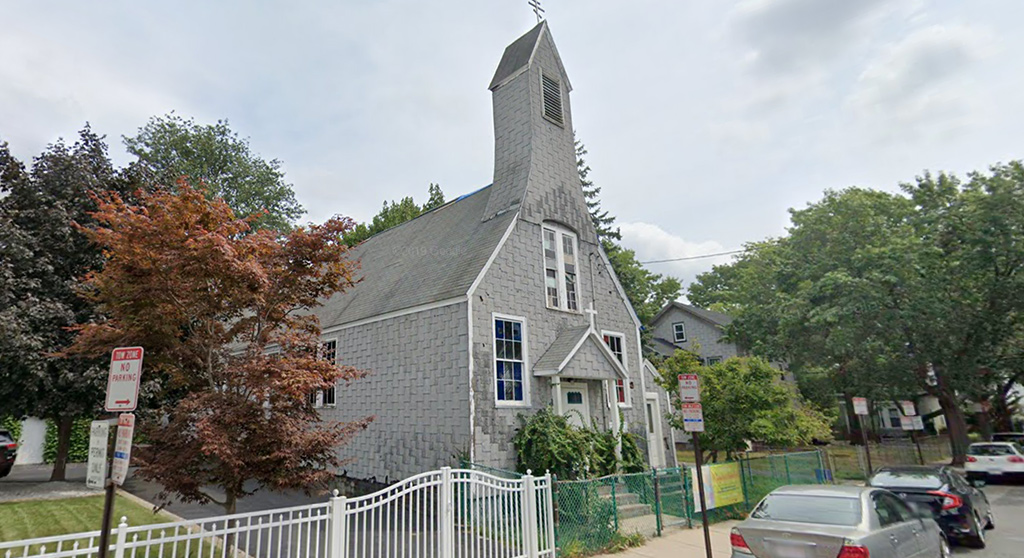
But as the Cambridgeport neighborhood grew and changed over the past half-century, and many of its Black residents have been displaced, St. Augustine’s has fallen into disrepair. In 2018, leaders of the Cambridgeport Neighborhood Association and members of the church community began the work of preserving and restoring the historic building. The Cambridge Historical Commission and other public and private organizations lent their support to this work, and in 2019 Black History in Action for Cambridgeport (BHAC) was born. Co-founded by Tufts University historian and Cambridgeport resident Kris Manjapra, BHAC’s goal is to bring together parishioners of St. Augustine’s, led by the Rev. Kit Eccles, local residents, and community leaders to preserve the church’s physical structure, and also its important place in the life of Cambridgeport’s Black community.
BHAC’s vision for the future of St. Augustine’s is one in which the congregation can be restored to the heart of Cambridgeport, both in substance and in spirit. The building’s roof was replaced in 2019, and an ongoing capital campaign aims to transform the space into a revitalized house of worship that also serves as a space for social justice and community engagement and for artistic and cultural programming. A new area, the Black Space for Arts and Empowerment, will host performances, meetings, and classes that serve the residents of Cambridgeport.
BHAC is committed to using the resources of the community, anchored at St. Augustine’s, to engage in historical research on Black Cambridgeport. Through the collection of oral histories, the creation of a tour of key cultural and historical neighborhood sites, and the curation of documents and artifacts from St. Augustine’s past, BHAC seeks to uncover and amplify the rich history of the African-Caribbean diaspora as it has existed for over a century in Cambridgeport. BHAC shares its findings with the broader community through in-person and virtual programming, as well as through its podcasts and on its website.
Learn more about BHAC, and support their efforts, by visiting their website. History Cambridge is proud to partner with and support the vital work that Black History in Action for Cambridgeport is undertaking to document and share the experiences of Black Cambridgeport residents, both past and present.
This article was originally published in our “Did You Know?” column in Cambridge Day.


